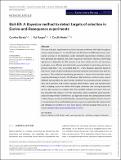Files in this item
Bait-ER : a Bayesian method to detect targets of selection in Evolve-and-Resequence experiments
Item metadata
| dc.contributor.author | Barata, Carolina De Castro Barbosa Rodrigues | |
| dc.contributor.author | Borges, Rui | |
| dc.contributor.author | Kosiol, Carolin | |
| dc.date.accessioned | 2022-12-22T10:30:06Z | |
| dc.date.available | 2022-12-22T10:30:06Z | |
| dc.date.issued | 2023-01-09 | |
| dc.identifier | 272668076 | |
| dc.identifier | c97214e0-776b-4dfa-a56e-e65cb29dfb50 | |
| dc.identifier | 85144905694 | |
| dc.identifier | 36544394 | |
| dc.identifier | 000901580800001 | |
| dc.identifier.citation | Barata , C D C B R , Borges , R & Kosiol , C 2023 , ' Bait-ER : a Bayesian method to detect targets of selection in Evolve-and-Resequence experiments ' , Journal of Evolutionary Biology , vol. 36 , no. 1 , pp. 29-44 . https://doi.org/10.1111/jeb.14134 | en |
| dc.identifier.issn | 1010-061X | |
| dc.identifier.other | ORCID: /0000-0002-4086-1636/work/125303076 | |
| dc.identifier.uri | https://hdl.handle.net/10023/26644 | |
| dc.description | funding: This research was funded in part, by the Vienna Science and Technology Fund (WWTF) [MA16-061], the Biotechnology and Biological Sciences Research Council (BBSRC) [BB/W000768/1], and the Austrian Science Fund (FWF) [P34524-B]. CK received funding from the Royal Society (RG170315) and Carnegie Trust (RIG007474). The computational results presented have been partly achieved using the St Andrews Bioinformatics Unit (StABU), which is funded by a Wellcome Trust ISSF award (grant 105621/Z/14/Z). | en |
| dc.description.abstract | For over a decade, experimental evolution has been combined with high-throughput sequencing techniques. In so-called Evolve-and-Resequence (E&R) experiments, populations are kept in the laboratory under controlled experimental conditions where their genomes are sampled and allele frequencies monitored. However, identifying signatures of adaptation in E&R datasets is far from trivial, and it is still necessary to develop more efficient and statistically sound methods for detecting selection in genome-wide data. Here, we present Bait-ER – a fully Bayesian approach based on the Moran model of allele evolution to estimate selection coefficients from E&R experiments. The model has overlapping generations, a feature that describes several experimental designs found in the literature. We tested our method under several different demographic and experimental conditions to assess its accuracy and precision, and it performs well in most scenarios. Nevertheless, some care must be taken when analysing trajectories where drift largely dominates and starting frequencies are low. We compare our method with other available software and report that ours has generally high accuracy even for trajectories whose complexity goes beyond a classical sweep model. Furthermore, our approach avoids the computational burden of simulating an empirical null distribution, outperforming available software in terms of computational time and facilitating its use on genome-wide data. We implemented and released our method in a new open-source software package that can be accessed at https://doi.org/10.5281/zenodo.7351736. | |
| dc.format.extent | 16 | |
| dc.format.extent | 2927553 | |
| dc.language.iso | eng | |
| dc.relation.ispartof | Journal of Evolutionary Biology | en |
| dc.subject | Bayesian inference | en |
| dc.subject | Selection coefficients | en |
| dc.subject | Targets of selection | en |
| dc.subject | E&R | en |
| dc.subject | Moran model | en |
| dc.subject | Pool-seq | en |
| dc.subject | QA75 Electronic computers. Computer science | en |
| dc.subject | QH301 Biology | en |
| dc.subject | QH426 Genetics | en |
| dc.subject | 3rd-DAS | en |
| dc.subject | MCC | en |
| dc.subject.lcc | QA75 | en |
| dc.subject.lcc | QH301 | en |
| dc.subject.lcc | QH426 | en |
| dc.title | Bait-ER : a Bayesian method to detect targets of selection in Evolve-and-Resequence experiments | en |
| dc.type | Journal article | en |
| dc.contributor.sponsor | BBSRC | en |
| dc.contributor.sponsor | Vienna Science and Technology Fund | en |
| dc.contributor.sponsor | The Royal Society | en |
| dc.contributor.sponsor | Carnegie Trust | en |
| dc.contributor.sponsor | The Wellcome Trust | en |
| dc.contributor.sponsor | Austrian Science Fund FWF | en |
| dc.contributor.institution | University of St Andrews. Centre for Biological Diversity | en |
| dc.contributor.institution | University of St Andrews. School of Biology | en |
| dc.identifier.doi | 10.1111/jeb.14134 | |
| dc.description.status | Peer reviewed | en |
| dc.identifier.url | https://doi.org/10.1101/2020.12.15.422880 | en |
| dc.identifier.grantnumber | BB/W000768/1 | en |
| dc.identifier.grantnumber | MA16-061 | en |
| dc.identifier.grantnumber | RG170315 | en |
| dc.identifier.grantnumber | RIG007474 | en |
| dc.identifier.grantnumber | 105621/Z/14/Z | en |
| dc.identifier.grantnumber | N/A | en |
This item appears in the following Collection(s)
Items in the St Andrews Research Repository are protected by copyright, with all rights reserved, unless otherwise indicated.

